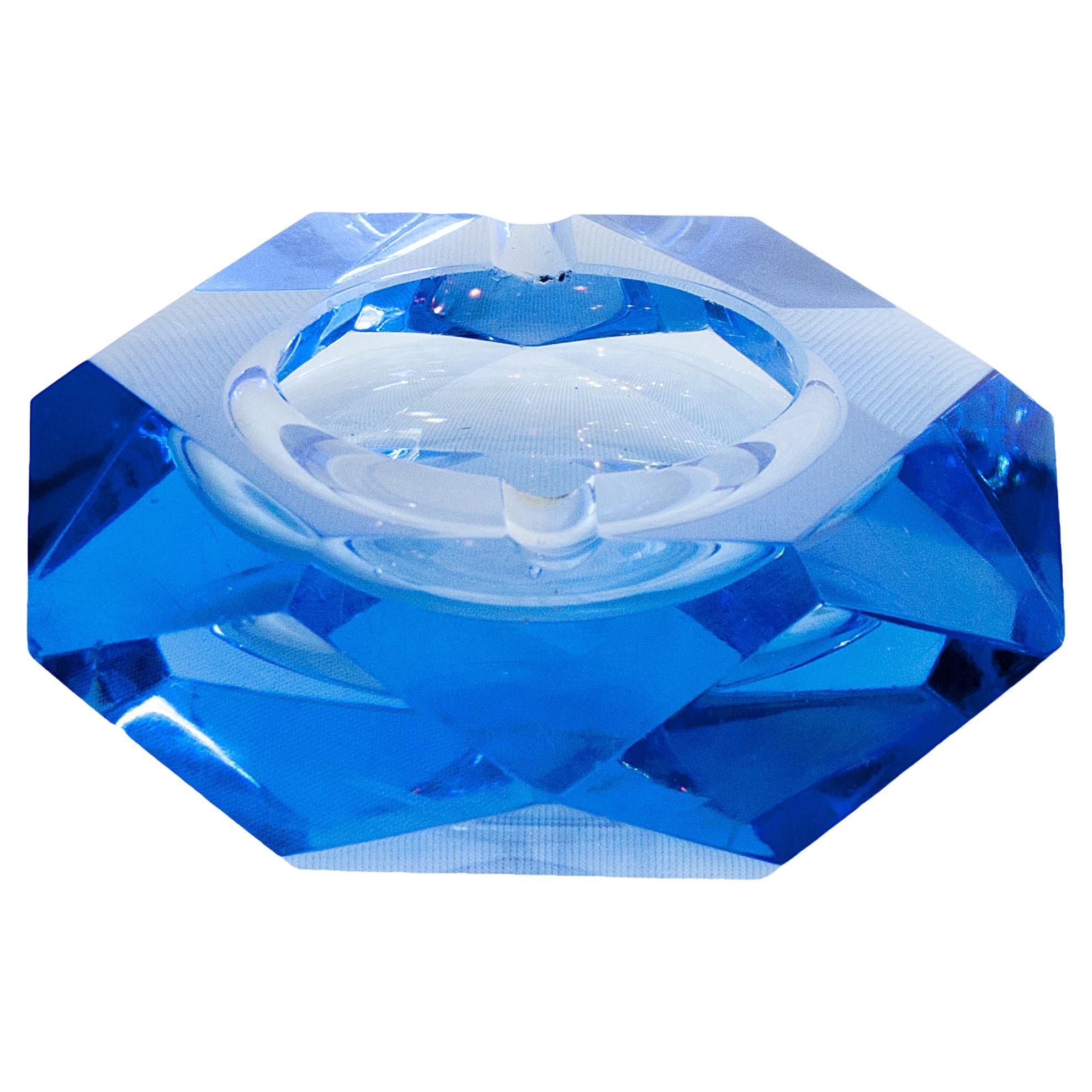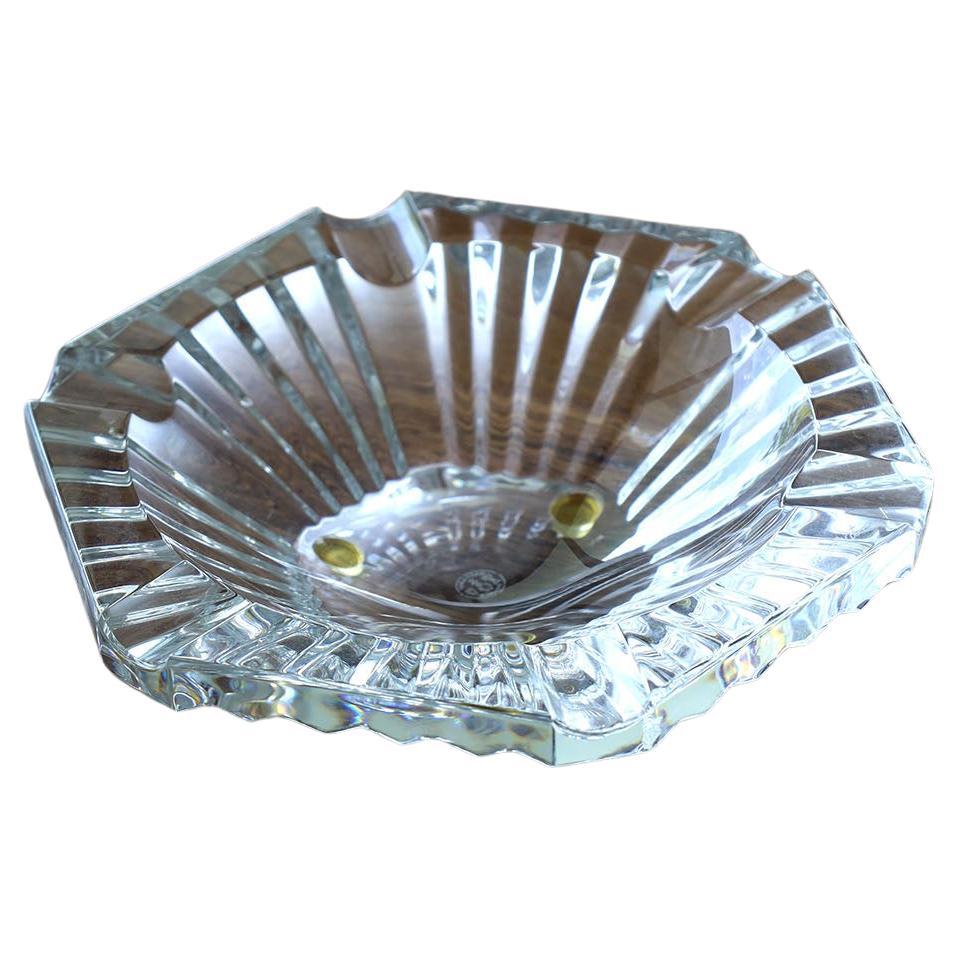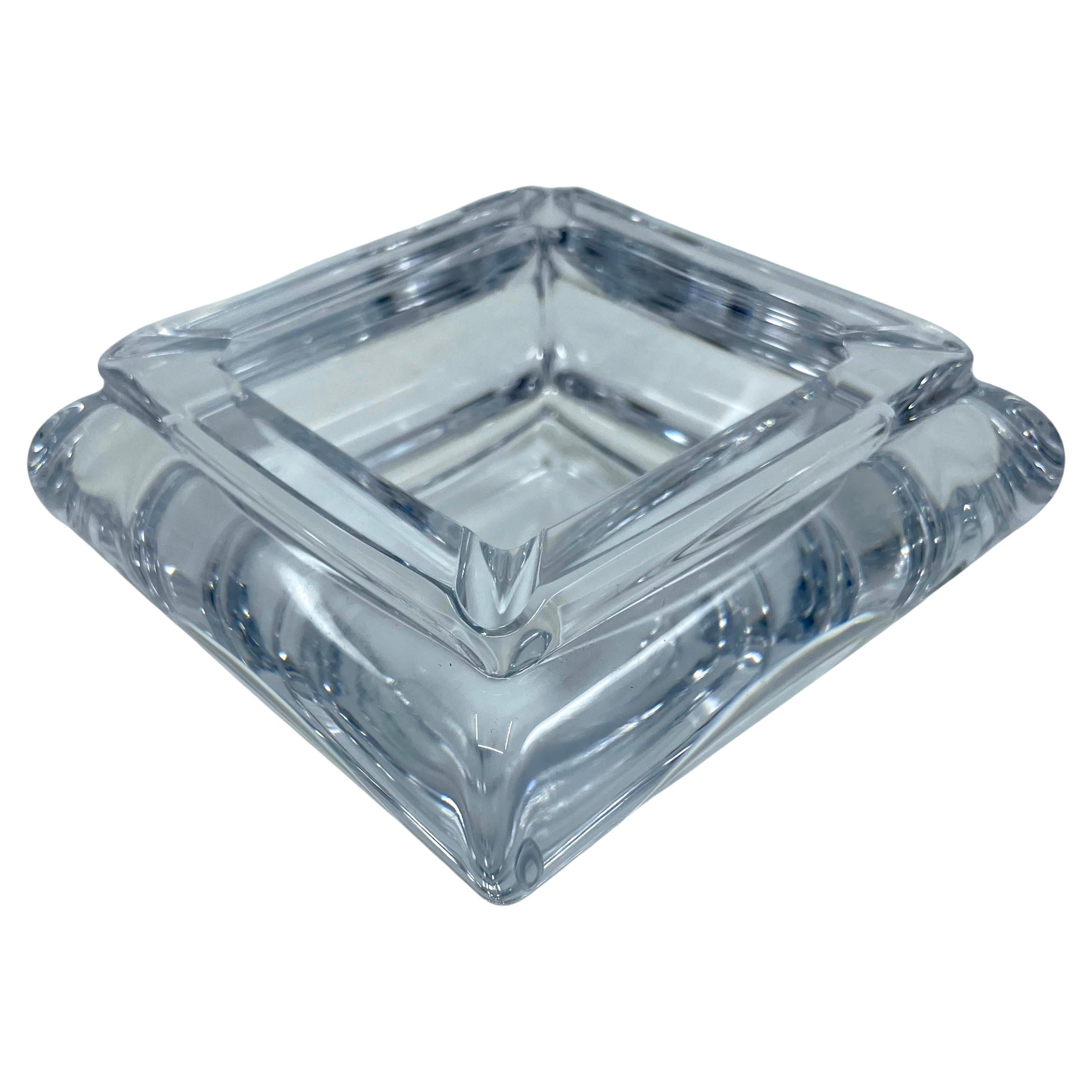Want more images or videos?
Request additional images or videos from the seller
1 of 12
Crystal Ashtray
About the Item
This ashtray or vide-poche is made of crystal. This is a French or Italian work. Circa 1970
- Dimensions:Height: 1.97 in (5 cm)Diameter: 7.09 in (18 cm)
- Style:Mid-Century Modern (Of the Period)
- Materials and Techniques:
- Place of Origin:
- Period:
- Date of Manufacture:1970
- Condition:Wear consistent with age and use. Minor fading.
- Seller Location:Marcq-en-Barœul, FR
- Reference Number:
About the Seller
5.0
Platinum Seller
These expertly vetted sellers are 1stDibs' most experienced sellers and are rated highest by our customers.
Established in 1979
1stDibs seller since 2018
262 sales on 1stDibs
Typical response time: 1 hour
- ShippingRetrieving quote...Ships From: Marcq-en-Baroeul, France
- Return PolicyA return for this item may be initiated within 7 days of delivery.
More From This SellerView All
- Bi-Color Cristal Ashtray, circa 1970Located in Marcq-en-Barœul, Hauts-de-FranceBi-color crystal ashtray, circa 1970.Category
Vintage 1970s French Mid-Century Modern Ashtrays
MaterialsCrystal
- Bronze Standing Ashtray with Lily Flower DecorLocated in Marcq-en-Barœul, Hauts-de-FranceThis standing ashtray is made of brass and bronze with lily flower decor. This is a French work. Circa 1940Category
Vintage 1940s French Neoclassical Ashtrays
MaterialsBronze
- Brass Ashtray on a Black Lacquered Metal Base, French Work, Circa 1950Located in Marcq-en-Barœul, Hauts-de-FranceThis ashtray is made of brass on a black lacquered metal base. This is a French work. Circa 1950.Category
Vintage 1950s French Mid-Century Modern Ashtrays
MaterialsMetal, Brass
- Bronze, Glass and Brass Ashtray on Stand by Maison BaguèsBy Maison BaguèsLocated in Marcq-en-Barœul, Hauts-de-FranceThis very nice and rare neoclassical style standing ashtray is made of bronze, glass and brass. The cut is formed by a laurel wreath and the tripod base with claw feet. On the center...Category
Vintage 1940s French Neoclassical Ashtrays
MaterialsBrass, Bronze
- Bi-Color Glass Vide-Poche, French Work, Circa 1970Located in Marcq-en-Barœul, Hauts-de-FranceThis vide-poche is made of bi-color glass. This is a French work. Circa 1970.Category
Vintage 1970s French Mid-Century Modern Decorative Dishes and Vide-Poche
MaterialsGlass
- Unusual Freeform Colored Crystal Cup, Signed, Scandinavia, circa 1970Located in Marcq-en-Barœul, Hauts-de-FranceThis freeform cup is made of colored crystal. This is a Scandinavian work, signed, circa 1970.Category
Vintage 1970s French Mid-Century Modern Vases
MaterialsCrystal
You May Also Like
- Ashtray Crystal, 1950Located in Ciudad Autónoma Buenos Aires, CCrystal We have specialized in the sale of Art Deco and Art Nouveau and Vintage styles since 1982. Why are there so many antiques in Argentina? In the 1880 – 1940 there was a grate wave of immigration encouraged by the periods of war that were taking place. 1st World War took place between 1914 and 1918 2nd World War took place between 1939 and 1945 The immigrants options were New York or Buenos Aires. Tickets were cheap and in Buenos Aires they were welcomed with open arms, as it was a country where everything was still to be done. Argentina was the country of new opportunities, labour was needed and religious freedom was assured, in many cases the of the family travel first until they were settled and then the rest of the family members join them. In the immigrant museum “Ellis Island Immigrant Building” in New York you can se the promotional posters of the boats that would take them to a new life. Between the years 1895 and 1896, Argentina had the highest DGP (gross domestic product) per capita in the world according to the Maddison Historical Statistics index, this situation arose due to the large amount of food being exported to European countries, which were at war. The Argentinean ships left the port of Buenos Aires with food, but they returned with furniture, clothes and construction elements, (it´s common to see this the old buildings of the historic neighbourhood of San Telmo, the beams with the inscription “Made in England)”, as well as many markets that were built in Buenos Aires, such us the San Telmo Market, whose structure was brought by ship and afterwards assembled in 900 Defensa Street. With the great influence of European immigrants living in the country, the children of the upper classes travelled to study in France, resulting in the inauguration of “La Maison Argentinienne”, on 27th of June 1928, in the international city of Paris, which hosted many Argentinians that were studying in Frace. It´s the fourth house to be built after France, Canada and Belgium, being the first Spanish-speaking one. Still in place today (17 Bd Jourdan, 75014, Paris, France). Many of the children of these wealthy families who attended international art exhibitions, museums and art courses abroad, took a keen interest in the European style. This is why Buenos Aires was at the time referred as “The Paris of South America”. Between the years 1890 and 1920 more than a hundred Palaces were built on Alvear Avenue the most exclusive avenue in Buenos Aires. Today some of these palaces have been transformed into museums, hotels and embassies. In the year 1936, the Kavanagh building was inaugurated, it was the tallest reinforced concrete building in South America. During 1994 the American Society of Civil Engineers distinguished it as an “international engineering milestone”, and it´s now considered a World Heritage of Modern Architecture. At the time was common to hire foreign architects such as Le Corbusier, who visited Buenos Aires/Argentina in 1929 and in 1948 he drew up the blueprints for a house built in La Plata City (which was declared a World Heritage Site). In 1947, the Hungarian architect Marcelo Breuer designed “Parador Ariston” in the seaside city of Mar del Plata. After an Argentinean student at Harvard University convinced him to come to Argentina. He worked on an urban development project in the Casa Amarilla, area of La Boca. The Ukrainian architect, Vladimiro Acosta, arrives in Argentina in 1928 and worked as an architect until que moved to Brazil. Antonio Bonet, a Spanish architect who worked with Le Corbusier in Paris, arrives in Argentina in 1937, where he carried out several architectural works and in 1938 designs the well-known BFK chair. Andres Kálnay, of Hungarian origin, made around 120 architectural masterpieces, among which the former Munich brewery stands out, he even made the furniture’s design. The German architect, Walter Gropius, director of the Bauhaus, lived in Argentina, where he wrote articles for “Sur” magazine and founded in Buenos Aires, an architectural firm with Franz Möller, who was also an architect, where he built two houses. At the same time several famous designers decided to immigrate to Argentina, among them we can find the well-known French designer, Jean-Michel Frank, who arrived in the country in 1940 and also worked for the Rockefeller family. Special pieces were made, which were sold exclusively in the country, such as the well-known German company “WMF”, who sold their products by catalogue, which were chosen by the ladies of high society in the list of wedding gifts, as well as the pieces designed by Christofle. The Swiss sculptor Alberto Giacometti, made special pieces for Argentinean mansions. In 1904 the first Jansen branch outside Paris was established in Buenos Aires, as the Argentinean clientele demanded a large amount of furniture, from the end of the 19th century to the mid-20th century. In 1970, the brand Rigolleau Argentina made pieces authorised by Lalique. The brands Maple and Thompson also set up shop in the country. The French plastic artist, Marcel Duchamp moved to Argentina in 1918-1919. Glass signed Gallé, Charder, Leverre, Schneider, Muller and other French firms. They were bought in flower shops and were given to ladies with beautiful floral arrangements. Some furniture manufacturers travelled to international fairs and bough the patterns to produce the furniture in Argentina, such as the furniture firm Englander and Bonta, who bought the patterns ins Italy. It is worth mentioning that in Argentina we have the largest community of Italians outside...Category
Vintage 1950s Italian Space Age Ashtrays
MaterialsCrystal
- Ashtray 1950 CrystalLocated in Ciudad Autónoma Buenos Aires, CCrystal We have specialized in the sale of Art Deco and Art Nouveau and Vintage styles since 1982. If you have any questions we are at your disposal. Pushing the button that reads ...Category
Vintage 1950s Italian Space Age Ashtrays
MaterialsCrystal
- Ashtray 1950 CrystalLocated in Ciudad Autónoma Buenos Aires, CCrystal We have specialized in the sale of Art Deco and Art Nouveau and Vintage styles since 1982. If you have any questions we are at your disposal. Pushing the button that reads ...Category
Vintage 1950s Italian Space Age Ashtrays
MaterialsCrystal
- Ashtray Crystal, 1950Located in Ciudad Autónoma Buenos Aires, CCrystal We have specialized in the sale of Art Deco and Art Nouveau and Vintage styles since 1982. If you have any questions we are at your disposal. Pushing the button that reads ...Category
Vintage 1950s Italian Space Age Ashtrays
MaterialsCrystal
- Baccarat Crystal AshtrayBy BaccaratLocated in Mérida, YUThis ashtray features the distinctive signs of style: a hexagonal form and flat cuts, giving it timelessness and functionality. Harcourt This is an iconic Baccarat piece. Bring eleg...Category
Vintage 1980s French American Classical Ashtrays
MaterialsCrystal
- Sevres Chunky Crystal AshtrayBy Manufacture Nationale de SèvresLocated in New York, NYSevres chunky crystal ashtray. Large heavy thick cushion carved Sevres crystal ashtray / vide poche with markings for Sevres crystal at base. France, Mid-20th Century. Dimensions: ...Category
Mid-20th Century French Mid-Century Modern Ashtrays
MaterialsCrystal
Recently Viewed
View AllMore Ways To Browse
Vintage Glass Lighters
Midcentury Modern Christmas Decor
Michael Jensen
Vintage Porcelain No Smoking Sign
Italy 25 Ashtray
French Crystal Ashtray
Footed Ashtray
Personal Ashtray
Lalique Old Fashion Glasses
Woman Ashtray
Italian Alabaster Ashtray
Art Deco Clear Glass Ashtray
Vintage Silent Butler
Hotel Logo Vintage Ashtrays
Animal Porcelain Hermes
Hans Bunde
Cut Glass Cigar Ashtray
Limoges Golf





